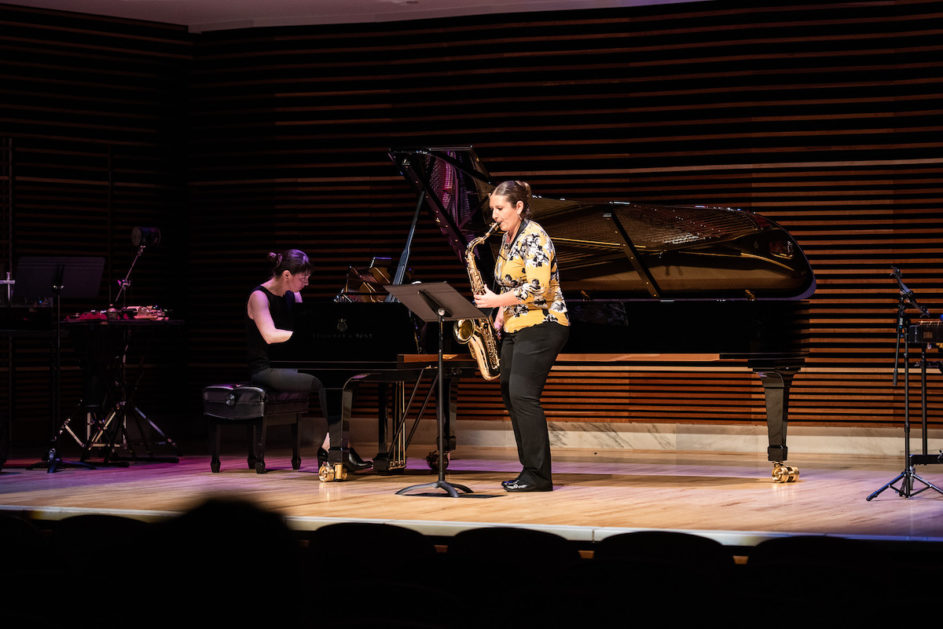Whether it’s Nief-Norf’s own concerts at the UT School of Music, or their appearances at Big Ears Festivals; encounters with the intriguing music on their programs or the brilliant and virtuoso performances of the musicians have never been anything less than astonishing.
Earlier this week, UT classical saxophonist Allison Adams, accompanied by percussionist Andrew Bliss, Nief-Norf’s artistic director, and pianist Andrea Lodge played a concert of brilliant new music, some of it especially written for Adams.
The opening piece on the program, Through All Panics, was composed for Adams by UT music professor and composer Andrew Sigler. When I asked Sigler what sound images he had in mind as he wrote the piece.
“I wasn’t thinking about anything in particular. I wanted to see if I could write anything Allison couldn’t do,” he said.
Classical saxophone players in the age of contemporary music have to have a lot of what is referred to as “extended techniques,” which means going far beyond the sweet melodies we are used to hearing in the music of Stravinsky, Gershwin or in jazz.
Through All Panics does have languid melodic lines and moments of dark, mysterious passages with sound colors unique to the saxophone. But it also has clicks, snaps and other idiomatic techniques that involve slap tongue and flutter tongue that produces dark harmonics.
Adams was astonishingly brilliant at every moment of it. She was matched by Lodge’s playing at the piano.
In two of the new solo études for unaccompanied saxophone in Tunisian composer Christian Lauba’s Neuf études for saxophone, written in 1992-1994, there were flat, unmusical tones and harsh mechanical sounds, machine horns and sounds like heavy squeaky hinges set against against lovely, shimmering harmonics played at pianissimo.
There were also pipe organ sounds, a siren and hot jazzy flourishes contrasted with what sounded like wind blowing against a slowly rotating steel panel.
In Hans Thomalia’s 2008 Leid, both Adams and Lodge played sound fragments like the attack of a note, with a slight pause, followed by the delicate decaying ending of a pitch. There was also sound blasts on the saxophone, accompanied by loud sound clusters made by Lodge’s entire forearm striking the piano keyboard.

Percussionist Andrew Bliss submerges metal pipes in a aquarium tank of water while Allison Adams plays the saxophone.
It was like the beginning and the fading ending of a phrase, with the rest of the sound stripped away.
In Erin Gee’s Mouthpiece XXIV, written in 2015, Bliss joined Adams. To her repertoire of sounds, Bliss struck metal pipes and small cymbals before submerging part of them in water, creating the effect of warped, descending sounds.
Lodge joined Adams again for the closing work on the program, Eric Wubbels’ This Is This Is This Is, written in 2009-2010.
It had both the impressionistic simplicity of Erik Satie, before splashy sound clusters on the piano and Lodge’s single-note trill that went on and on.
Just reading about this concert may give the impression of random warehouse and train-station noises that have little to do with music. But being present for the experience was enthralling. I could listen to it over and over.
Nief-Norf’s concert schedule can be found at www.niefnorf.org.
Sunday afternoon at 4 p.m., at Cox Auditorium, Bliss will lead another of his excellent music ensembles, UT Percussion Ensemble, which recently won first place at the 2018 PAS International Percussion Ensemble Competition.
Sunday’s concert is a special performance of a program the Ensemble will be performing in Indianapolis, the reward for their first place finish.

